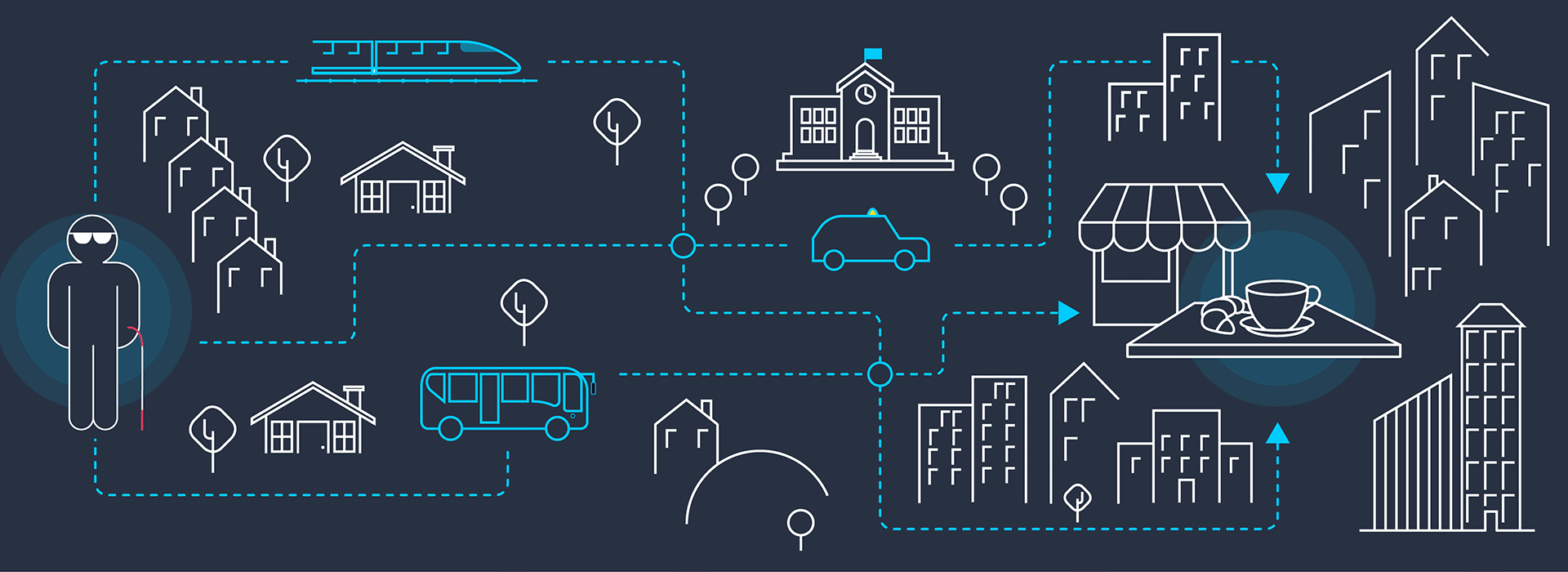As a blind person, there is nothing more frustrating than standing at a bus stop in my native London and have a stream of double-deckers sail by without knowing whether one was mine.
As a telecoms analyst of some 30 years, I am equally frustrated that the technology is out there to give me the information but it is neither integrated nor accessible. So, what’s missing and how close are we to making smart services in the city accessible to all?
My framework for thinking about this is a series of concentric circles with the individual at the centre with rings of household, local neighbourhood, society and business surrounding them (see Figure 1).

Figure 1: Living in an increasingly digital environment
Let the data flow
The digitization of mapping information has revolutionized navigation. However, putting all information relating to a city environment into a single system is unlikely given political structures. That said, some, like New York have appointed a head of accessible integrated transport for the first time. And an open data approach by the city authorities, such as that by Transport for London, allows third parties to integrate data into appropriate applications. Moving around the city is therefore facilitated by information sources about transport options, shops, civil facilities as well as those essential media and entertainment outlets. Many of these have been isolated systems in the past.
“The smartphone features to serve as a proxy for senses that might be denied to the individual”
5G represents not only an opportunity to provide complementary location input but also the range of connection possibilities in terms of bandwidth and latency. It will support all of the smartphone features to serve as a proxy for senses that might be denied to the individual: the cameras become the eyes, the microphone the ears and the processor can help with cognitive issues. Add to this a range of wearables to act as extra sensors for the device and we have the basis of embedding the individual at the heart of the digital environment.
Recent events have brought the focus onto how we help people at home – both from a medical as well as a remote working angle. Once working patterns settle down post-Covid, the emphasis will be more on health and social care. 5G can act as the facilitator for two-way interaction with individuals and, of course, the development of robotic technology can increasingly offer support in the home.
“Many of those digitally excluded are disabled or fall into the higher age category”
We’re generally more comfortable with the use of video to interact with the healthcare system at all levels. Secure, reliable affordable communications in every household will be a major benefit of 5G deployment. However additional efforts are still needed to bring connectivity to every member of society. Not surprisingly, many of those digitally excluded are disabled or fall into the higher age category.
This raises the question of where information flows. The reality will be multiple data sources from the individual. Some will go back to the individual, some to public authorities, some to carers and families, some to medical staff and doubtless others. Since 5G offers us the possibility of segmentation of the full network with dedicated resources, this would be an ideal use of 5G slicing to deliver specific services. For example, many elderly people fail to wear their emergency response devices, so falls and illness can go undetected for significant periods of time. Wouldn’t it be better for all concerned if the house could monitor the activity of that individual: switching off the kettle, moving around the household, taking medication? Perhaps a little too intrusive for some, but potentially lifesaving for many.
A smarter interface
One of my favourite developments in recent years is the smart speaker. Some have an issue with their intrusiveness but as a blind person, they help me manage online shopping, the household lighting and heating as well as, and most importantly, giving me access to sports radio and music. Designed for the masses, they actually help various categories of disabled people as well as those with more limited digital skills.
The interface is, of course, absolutely key. With the smart speaker, it is easy to ask about the weather, call a taxi, find out when the refuse is being collected, shop online, find out which doctor is on call or ask for something to cheer you up. While enormous strides have been made in making mobile phone and computer interfaces more accessible, giving people a choice of how they interact with all of these applications is vital.
“Application must be designed and developed for inclusion from the outset”
Application must be designed and developed for inclusion from the outset. Any attempt to bolt on an accessibility facility after the fact rarely succeeds. Having inclusivity at the heart of all application iterations is also central to keeping everyone connected. There is nothing more frustrating than accessing an application, for example, for an airline, that was previously accessible to find a new version just blurts out ‘button, button, button’ as I scroll across the screen instead of telling me when and where my next trip is going to be.
Figure 2: The city that understands my needs

So, rather than the frustrating experience at the bus stop, in the future my device will give me the options of how best to get to my destination by public transport and perhaps even the option of an autonomous taxi picking me up and dropping me off at the right place. If I were a wheelchair user, it could also drop me at the ramp accessible door. Furthermore, once inside a building, my navigation application will tap into the smart building systems and guide me to the appropriate room. Perhaps it’s a stretch for an espresso and almond croissant to be waiting for me when I get there, but this emphasises the benefits of providing access to all available information and having it fed into an accessible system (see Figure 2).
The beauty of this is that simply designed, data-rich environments will benefit everyone. And, as we bridge the digital divide and bring everyone into the fold, the cost of running services in a city will decrease. In effect, this is a marriage of the outside-in and inside-out approach. The city and its services digitise their services and the individual benefits from digital services and connected devices.
Finally, with 5G being deployed on a national basis, this thinking does not need to be restricted to big city dwellers. In the future, towns and rural communities will have equal access to connectivity and integration of all local data and services – literally making everyone’s lives easier.
What is needed to make this scenario a reality? Quite simply, ubiquitous high-quality connectivity from the telecoms industry combined with design and integrated data management and joined up thinking from the relevant authorities, to make all services accessible to the whole community. The result? A city built for the needs of everyone.
Please note: This article was originally published by Nokia.com.
